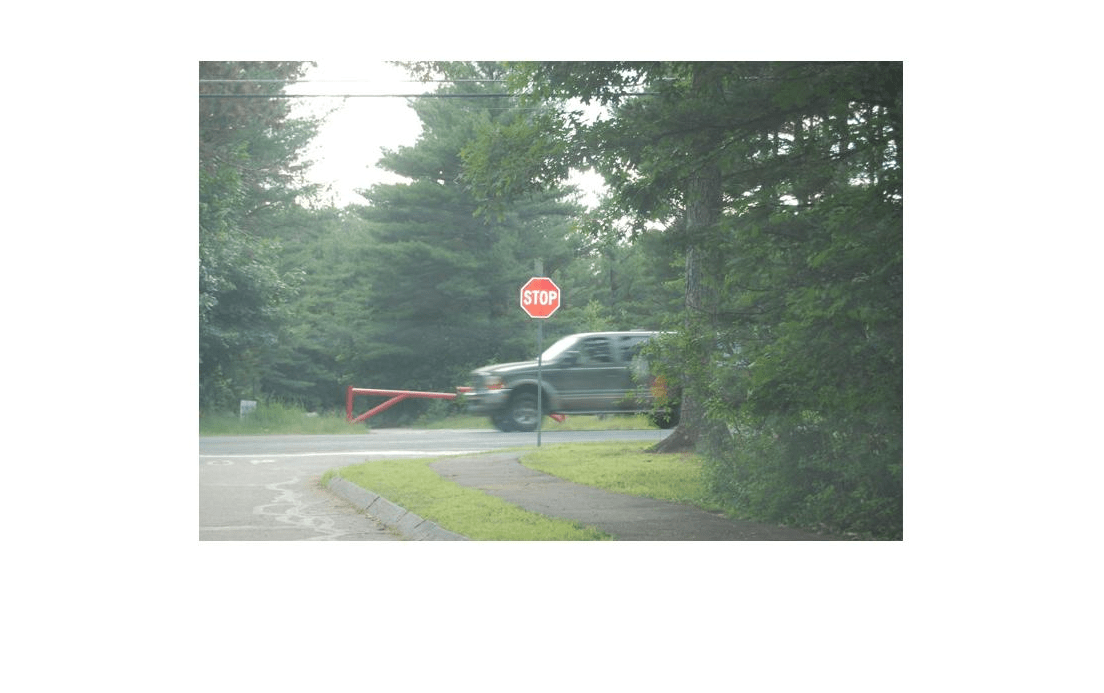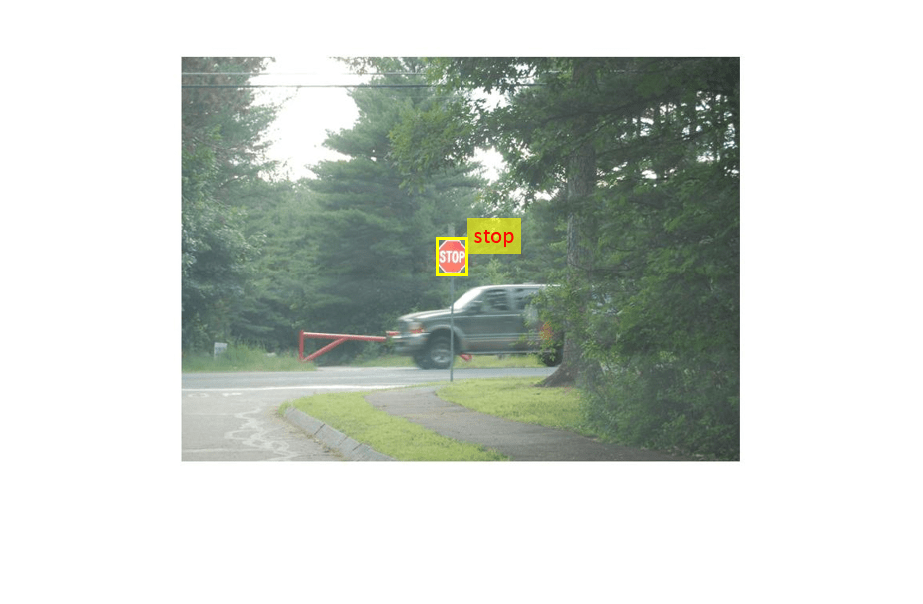Traffic Sign Detection and Recognition
This example shows how to generate CUDA® MEX code for a traffic sign detection and recognition application that uses deep learning. Traffic sign detection and recognition is an important application for driver assistance systems, aiding and providing information to the driver about road signs.

In this traffic sign detection and recognition example you perform three steps - detection, Non-Maximal Suppression (NMS), and recognition. First, the example detects the traffic signs on an input image by using an object detection network that is a variant of the You Only Look Once (YOLO) network. Then, overlapping detections are suppressed by using the NMS algorithm. Finally, the recognition network classifies the detected traffic signs.
第三方Prerequisites
Required
This example generates CUDA MEX and has the following third-party requirements.
CUDA® enabled NVIDIA® GPU and compatible driver.
Optional
For non-MEX builds such as static, dynamic libraries or executables, this example has the following additional requirements.
NVIDIA toolkit.
NVIDIA cuDNN library.
Environment variables for the compilers and libraries. For more information, seeThird-Party HardwareandSetting Up the Prerequisite Products.
Verify GPU Environment
Use thecoder.checkGpuInstallfunction to verify that the compilers and libraries necessary for running this example are set up correctly.
envCfg = coder.gpuEnvConfig('host'); envCfg.DeepLibTarget ='cudnn'; envCfg.DeepCodegen = 1; envCfg.Quiet = 1; coder.checkGpuInstall(envCfg);
Detection and Recognition Networks
The detection network is trained in the Darknet framework and imported into MATLAB® for inference. Because the size of the traffic sign is relatively small with respect to that of the image and the number of training samples per class are fewer in the training data, all the traffic signs are considered as a single class for training the detection network.
The detection network divides the input image into a 7-by-7 grid. Each grid cell detects a traffic sign if the center of the traffic sign falls within the grid cell. Each cell predicts two bounding boxes and confidence scores for these bounding boxes. Confidence scores indicate whether the box contains an object or not. Each cell predicts on probability for finding the traffic sign in the grid cell. The final score is product of the preceding scores. You apply a threshold of 0.2 on this final score to select the detections.
The recognition network is trained on the same images by using MATLAB.
ThetrainRecognitionnet.mhelper script shows the recognition network training.
Get the Pretrained Detector and Recognition Networks
This example uses theyolo_tsrandRecognitionNetMAT-files containing the pretrained networks. The files are approximately 6MB and 992MB in size, respectively. Download the files from the MathWorks website.
detectorNet = matlab.internal.examples.downloadSupportFile('gpucoder/cnn_models/traffic_sign_detection/v001','yolo_tsr.mat'); recognitionNet = matlab.internal.examples.downloadSupportFile('gpucoder/cnn_models/traffic_sign_detection/v001','RecognitionNet.mat');
The detection network contains 58 layers including convolution, leaky ReLU, and fully connected layers.
load(detectorNet); yolo
yolo = SeriesNetwork with properties: Layers: [58×1 nnet.cnn.layer.Layer] InputNames: {'input'} OutputNames: {'classoutput'}
To view the network architecture, use theanalyzeNetwork(Deep Learning Toolbox)function.
analyzeNetwork(yolo)
The recognition network contains 14 layers including convolution, fully connected, and the classification output layers.
load(recognitionNet); convnet
convnet = SeriesNetwork with properties: Layers: [14×1 nnet.cnn.layer.Layer] InputNames: {'imageinput'} OutputNames: {'classoutput'}
Thetsdr_predictEntry-Point Function
Thetsdr_predict.mentry-point function takes an image input and detects the traffic signs in the image by using the detection network. The function suppresses the overlapping detections (NMS) by usingselectStrongestBboxand recognizes the traffic sign by using the recognition network. The function loads the network objects fromyolo_tsr.matinto a persistent variabledetectionnetand theRecognitionNet.matinto a persistent variablerecognitionnet. The function reuses the persistent objects on subsequent calls.
type('tsdr_predict.m')
function [selectedBbox,idx] = tsdr_predict(img,detectorMATFile,recogMATFile) %#codegen coder.gpu.kernelfun; % resize the image img_rz = imresize(img,[448,448]); % Converting into BGR format img_rz = img_rz(:,:,3:-1:1); img_rz = im2single(img_rz); %% TSD persistent detectionnet; if isempty(detectionnet) detectionnet = coder.loadDeepLearningNetwork(detectorMATFile,'Detection'); end predictions = detectionnet.activations(img_rz,56,'OutputAs','channels'); %% Convert predictions to bounding box attributes classes = 1; num = 2; side = 7; thresh = 0.2; [h,w,~] = size(img); boxes = single(zeros(0,4)); probs = single(zeros(0,1)); for i = 0:(side*side)-1 for n = 0:num-1 p_index = side*side*classes + i*num + n + 1; scale = predictions(p_index); prob = zeros(1,classes+1); for j = 0:classes class_index = i*classes + 1; tempProb = scale*predictions(class_index+j); if tempProb > thresh row = floor(i / side); col = mod(i,side); box_index = side*side*(classes + num) + (i*num + n)*4 + 1; bxX = (predictions(box_index + 0) + col) / side; bxY = (predictions(box_index + 1) + row) / side; bxW = (predictions(box_index + 2)^2); bxH = (predictions(box_index + 3)^2); prob(j+1) = tempProb; probs = [probs;tempProb]; boxX = (bxX-bxW/2)*w+1; boxY = (bxY-bxH/2)*h+1; boxW = bxW*w; boxH = bxH*h; boxes = [boxes; boxX,boxY,boxW,boxH]; end end end end %% Run Non-Maximal Suppression on the detected bounding boxess coder.varsize('selectedBbox',[98, 4],[1 0]); [selectedBbox,~] = selectStrongestBbox(round(boxes),probs); %% Recognition persistent recognitionnet; if isempty(recognitionnet) recognitionnet = coder.loadDeepLearningNetwork(recogMATFile,'Recognition'); end idx = zeros(size(selectedBbox,1),1); inpImg = coder.nullcopy(zeros(48,48,3,size(selectedBbox,1))); for i = 1:size(selectedBbox,1) ymin = selectedBbox(i,2); ymax = ymin+selectedBbox(i,4); xmin = selectedBbox(i,1); xmax = xmin+selectedBbox(i,3); % Resize Image inpImg(:,:,:,i) = imresize(img(ymin:ymax,xmin:xmax,:),[48,48]); end for i = 1:size(selectedBbox,1) output = recognitionnet.predict(inpImg(:,:,:,i)); [~,idx(i)]=max(output); end % Copyright 2017-2022 The MathWorks, Inc.
Generate CUDA MEX for thetsdr_predictFunction
Create a GPU configuration object for a MEX target and set the target language to C++. Use thecoder.DeepLearningConfigfunction to create aCuDNNdeep learning configuration object and assign it to theDeepLearningConfigproperty of the GPU code configuration object. To generate CUDA MEX, use thecodegencommand and specify the input to be of size [480,704,3]. This value corresponds to the input image size of thetsdr_predictfunction.
cfg = coder.gpuConfig('mex'); cfg.TargetLang ='C++'; cfg.DeepLearningConfig = coder.DeepLearningConfig('cudnn'); inputArgs = {ones(480,704,3,'uint8'),coder.Constant(detectorNet),...coder.Constant(recognitionNet)}; codegen-configcfgtsdr_predict-argsinputArgs报告
Code generation successful: View report
To generate code by using TensorRT, passcoder.DeepLearningConfig('tensorrt')as an option to the coder configuration object instead of'cudnn'.
Run Generated MEX
Load an input image.
im = imread('stop.jpg'); imshow(im);

Calltsdr_predict_mexon the input image.
im = imresize(im, [480,704]); [bboxes,classes] = tsdr_predict_mex(im,detectorNet,recognitionNet);
Map the class numbers to traffic sign names in the class dictionary.
classNames = {...'addedLane',“慢”,'dip','speedLimit25','speedLimit35','speedLimit40',...'speedLimit45','speedLimit50','speedLimit55','speedLimit65',...'speedLimitUrdbl','doNotPass','intersection','keepRight','laneEnds',...'merge','noLeftTurn','noRightTurn','stop','pedestrianCrossing',...'stopAhead','rampSpeedAdvisory20','rampSpeedAdvisory45',...'truckSpeedLimit55','rampSpeedAdvisory50','turnLeft',...'rampSpeedAdvisoryUrdbl','turnRight','rightLaneMustTurn','yield',...'yieldAhead','school','schoolSpeedLimit25','zoneAhead45','signalAhead'}; classRec = classNames(classes);
Display the detected traffic signs.
outputImage = insertShape(im,'Rectangle',bboxes,'LineWidth',3);fori = 1:size(bboxes,1) outputImage = insertText(outputImage,[bboxes(i,1)+...bboxes(i,3) bboxes(i,2)-20],classRec{i},'FontSize',20,...'TextColor','red');endimshow(outputImage);

Traffic Sign Detection and Recognition on a Video
The included helper filetsdr_testVideo.mgrabs frames from the test video, performs traffic sign detection and recognition, and plots the results on each frame of the test video.
typetsdr_testVideo
函数tsdr_testVideo %版权2017 - 2022MathWorks, Inc. % Input video v = VideoReader('stop.avi'); %% Generate Code for Traffic Sign Detection and Recognition % Create a GPU Configuration object for MEX target setting target language % to C++. Run the |codegen| command specifying an input of input video % frame size. This corresponds to the input image size of tsdr_predict % function. cfg = coder.gpuConfig('mex'); cfg.TargetLang = 'C++'; cfg.DeepLearningConfig = coder.DeepLearningConfig('cudnn'); inputArgs = {ones(480,704,3,'uint8'),coder.constant(detectorNet),... coder.Constant(recognitionNet)}; codegen -config cfg tsdr_predict -args inputArgs -report fps = 0; while hasFrame(v) % Take a frame picture = readFrame(v); picture = imresize(picture,[480,704]); % Call MEX function for Traffic Sign Detection and Recognition tic; [bboxes,clases] = tsdr_predict_mex(picture,detectorNet,recognitionNet); newt = toc; % fps fps = .9*fps + .1*(1/newt); % display diplayDetections(picture,bboxes,clases,fps); end end function diplayDetections(im,boundingBoxes,classIndices,fps) % Function for inserting the detected bounding boxes and recognized classes % and displaying the result % % Inputs : % % im : Input test image % boundingBoxes : Detected bounding boxes % classIndices : Corresponding classes % % Traffic Signs (35) classNames = {'addedLane','slow','dip','speedLimit25','speedLimit35',... 'speedLimit40','speedLimit45','speedLimit50','speedLimit55',... 'speedLimit65','speedLimitUrdbl','doNotPass','intersection',... 'keepRight','laneEnds','merge','noLeftTurn','noRightTurn','stop',... 'pedestrianCrossing','stopAhead','rampSpeedAdvisory20',... 'rampSpeedAdvisory45','truckSpeedLimit55','rampSpeedAdvisory50',... 'turnLeft','rampSpeedAdvisoryUrdbl','turnRight','rightLaneMustTurn',... 'yield','yieldAhead','school','schoolSpeedLimit25','zoneAhead45',... 'signalAhead'}; outputImage = insertShape(im,'Rectangle',boundingBoxes,'LineWidth',3); for i = 1:size(boundingBoxes,1) ymin = boundingBoxes(i,2); xmin = boundingBoxes(i,1); xmax = xmin+boundingBoxes(i,3); % inserting class as text at YOLO detection classRec = classNames{classIndices(i)}; outputImage = insertText(outputImage,[xmax ymin-20],classRec,... 'FontSize',20,'TextColor','red'); end outputImage = insertText(outputImage,... round(([size(outputImage,1) 40]/2)-20),... ['Frame Rate: ',num2str(fps)],'FontSize',20,'TextColor','red'); imshow(outputImage); end
